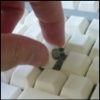LivingDesktop: Augmenting Desktop Workstation with Actuated Devices (CHI'16)
We investigate the potential benefits of actuated devices for the desktop workstation which remains the most used environment for daily office works. A formative study reveals that the desktop workstation is not a fixed environment because users manually change the position and the orientation of their devices. Based on these findings, we present the LivingDesktop, an augmented desktop workstation with devices (mouse, keyboard, monitor) capable of moving au- tonomously. We describe interaction techniques and applica- tions illustrating how actuated desktop workstations can improve ergonomics, foster collaboration, leverage context and reinforce physicality. Finally, the findings of a scenario evaluation are (1) the perceived usefulness of ergonomics and collaboration applications; (2) how the LivingDesktop inspired our participants to elaborate novel accessibility and social applications; (3) the location and user practices should be con- sidered when designed actuated desktop devices.
| The LivingDesktop is an augmented desktop with the mouse, keyboard and monitor capable of moving to improve ergonomics, foster collaboration, leverage context and reinforce physicality in the desktop workstation |
| The Living Desktop proof-of-concept | |
| Living Desktop setup consisting of a mouse, keyboard and monitor as well as a depth camera to track their position on the desk |  |
| a rail for translation. Right. The keyboard is augmented with a robotic base allowing translation (T xz) an rotation (Ry) of the device |  |
| (A) Mouse augmented with two magnets. (B) A plotter under the desk control the the position of the mouse. (C0 An arm with two magnets to couple (or not) the mosue to the plotter. |  |
| Top: The image is segmented by depth and color to track objects. Bottom: ”pointing” gesture before and after depth segmentation. |  |
| The seven features of the LivingDesktop for the proposed applications. (1) Applications inspired from the formative study are marked with *; Novel applications are in bold; (2) Device; (3) Degrees of freedom (DOFs); (4) modality related to levels of perception; (5) Degree of control; (6) Interaction; (7) Sensing context. |  |
| The user rotates the monitor to share screen content with his co-worker by using a dedicated key on the keyboard and moving the mouse. | |
| The user presses a dedicated key and points towards an object to make sure that this object is inside the field of view of the webcam and visible from the remote user. | |
| The monitor follows the user to be readable when working on her companion standing table. | |
| The LivingDesktop anticipates when the user wants to put an object on the desk and make room for it. | |
| The monitor acts as a peephole display over the virtual space. | |
| The relative position of the secondary monitor fits the virtual spatial configuration. | |
| A summary of participants responses to the 7-point Likert scale questions with the median indicated. |
Images
Archive containing the different images : LivingDesktop-archive.zip (5mo)Press
- Une forme qui s'adapte au fond. CNRS Magazine (french); (May 2016) link
- Ce bureau vivant s'adapte à vos besoins en tremps réels from Jérémy Heleine. FredZone (french); (May 2016) link
- Juliette Raynal. Magazine Industrie and Technologies. (May 2016) link
References
 |
Gilles Bailly, Sidharth Sahdev, Sylvain Malacria, Thomas Pietrzak LivingDesktop: Augmenting Desktop Workstation with Actuated Devices ACM CHI'16, 10+3 pages. |
Related Projects
 |
Gilles Bailly, Thomas Pietrzak, Jonathan Deber, Daniel Wigdor Metamorphe: Augmenting Hotkey Usage with Actuated Keys ACM CHI'13, 10 pages. |